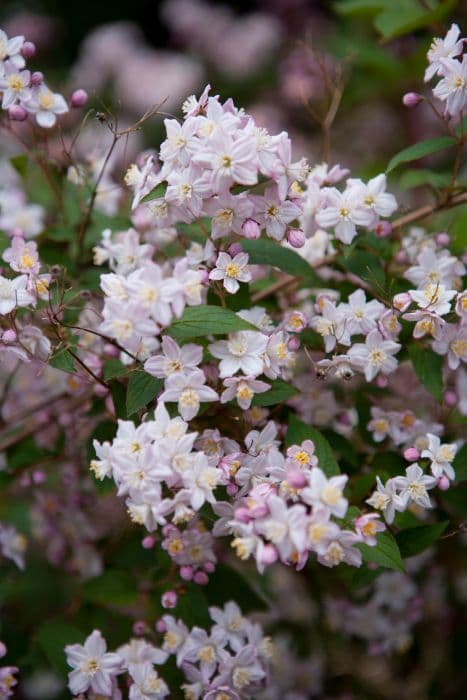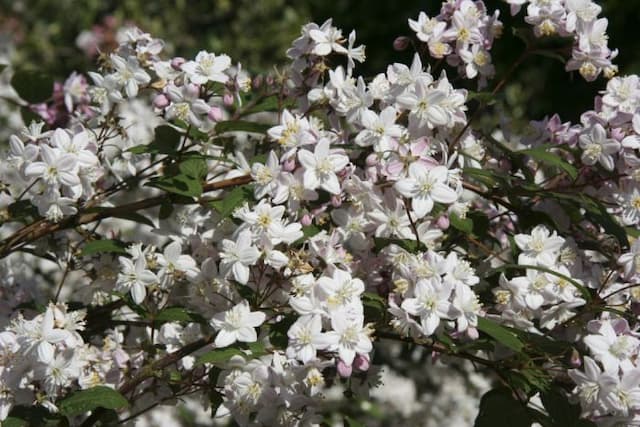Rough-leaved Hydrangea Hydrangea aspera (Kawakamii Group) 'Taiwan'

ABOUT
The Hydrangea aspera 'Taiwan' is a striking plant adorned with standout foliage and beautiful flowers. The leaves are typically large, with a slightly fuzzy texture, exuding a soft, velvety feel to the touch. Their color is a deep green, providing a lush backdrop for the plant's impressive blossoms. The flowers of the 'Taiwan' hydrangea are particularly noteworthy, arranged in lacecap form—a flat, circular cluster of tiny, fertile flowers surrounded by larger, infertile showy flowers. These blossoms often display a mix of colors, with the smaller flowers taking on a subtle, purplish or blue hue, while the outer, larger petals might be a lighter shade, often a soft pink or mauve, adding a two-tone effect to the overall floral display. The stems of the plant are sturdy, holding up the large leaves and flower heads with a robust presence in the garden. As seasons change, the flowers may also change color slightly, adding to the plant's dynamic and appealing appearance throughout its blooming period. The overall look of the plant is lush and ornamental, making it a captivating choice for gardeners looking to add a touch of drama and natural beauty to their outdoor spaces.
About this plant
 Names
NamesFamily
Hydrangeaceae.
Synonyms
Rough-leaved Hydrangea, Villosa Hydrangea, Hairy Hydrangea, Aspera Hydrangea.
Common names
Hydrangea aspera 'Kawakamii Group', Hydrangea kawakamii.
 Toxicity
ToxicityTo humans
Rough-leaved hydrangea, commonly known as Hydrangea aspera 'Taiwan', contains compounds that are considered to have low toxicity to humans. However, if ingested, parts of the plant, especially the leaves and buds, may cause gastrointestinal upset, including symptoms like vomiting and diarrhea. In some cases, the plant may also cause mild dermatitis or skin irritation upon contact, although this is not common. It is advisable to keep this plant out of the reach of children who might be tempted to ingest plant parts due to their attractive flowers.
To pets
Rough-leaved hydrangea, is known to have low to moderate toxicity to pets such as cats and dogs. If pets ingest parts of this plant, they could experience symptoms of poisoning. The main component causing toxicity is the presence of cyanogenic glycosides, which can release cyanide when the plant material is damaged. Symptoms of poisoning in pets may include vomiting, diarrhea, lethargy, abdominal pain, and in some cases, more severe symptoms such as depression, breathing difficulties, or an increase in heart rate and body temperature. If you suspect your pet has ingested rough-leaved hydrangea, it is crucial to seek veterinary care immediately.
 Characteristics
CharacteristicsLife cycle
Perennials
Foliage type
Deciduous
Color of leaves
Green
Flower color
Mauve
Height
10 feet (3 meters)
Spread
8 feet (2.4 meters)
Plant type
Shrub
Hardiness zones
7
Native area
Taiwan
Benefits
 General Benefits
General Benefits- Aesthetic Appeal: Hydrangea aspera 'Taiwan' adds visual interest to gardens with its large, textured leaves and beautiful, lacecap flowers that bloom in the summer.
- Pollinator Attraction: The flowers attract bees, butterflies, and other beneficial pollinators that support a healthy ecosystem.
- Landscape Versatility: This plant can be used in a variety of garden designs, including as a specimen plant, in borders, or as part of a woodland garden.
- Seasonal Interest: It provides multi-seasonal interest with flowers in summer and peeling bark in winter.
- Erosion Control: The shrub's extensive root system can help stabilize soil and prevent erosion on slopes or banks.
- Habitat Creation: It can provide shelter and nesting sites for birds and other wildlife.
 Medical Properties
Medical PropertiesThis plant is not used for medical purposes.
 Air-purifying Qualities
Air-purifying QualitiesThis plant is not specifically known for air purifying qualities.
 Other Uses
Other Uses- Artistic inspiration: Artists and photographers may find the striking blooms and foliage of Hydrangea aspera an intriguing subject for artwork and photographic compositions.
- Dried flower arrangements: The flowers and leaves of the Hydrangea can be dried and used in long-lasting floral displays.
- Education and research: Horticulture students and botanists may study the Hydrangea for its unique characteristics and adaptability in various climates.
- Garden design: Landscape architects may use Hydrangea aspera to create a focal point or to add texture and color contrasts in garden designs.
- Textile patterns: The distinctive patterning of the Hydrangea’s blooms can inspire designs for fabrics, wallpapers, and other textiles.
- Cultural events: Hydrangeas are often associated with specific cultural events and may be used in festivals or ceremonies to symbolize heartfelt emotions or gratitude.
- Eco-friendly wrapping: Leaves of the Hydrangea can occasionally be used as natural and decorative wrapping for small gifts.
- Crafting: Hydrangea petals and leaves can be incorporated into handmade paper or used to create eco-friendly confetti.
- Habitat support: The Hydrangea can provide shelter and food for birds and insects in the garden, thereby supporting local biodiversity.
- Seasonal decoration: Branches with flowers or colorful autumn leaves can be used for creating seasonal wreaths or other decorations.
Interesting Facts
 Feng Shui
Feng ShuiThe Rough-leaved Hydrangea is not used in Feng Shui practice.
 Zodiac Sign Compitability
Zodiac Sign CompitabilityThe Rough-leaved Hydrangea is not used in astrology practice.
 Plant Symbolism
Plant Symbolism- Heartfelt Emotions: Hydrangeas often symbolize deep and heartfelt emotions, whether they be of joy or sadness.
- Vanity: In certain cultures, the hydrangea can represent vanity or boastfulness due to its abundant and showy flowers.
- Gratitude: The lavish blooms of the hydrangea can stand for expressions of gratitude, making them a popular gift to say thanks.
- Understanding: Some interpret the hydrangea's complexity as a symbol of understanding and deeper insight.
- Frivolity: The light and airy feel of hydrangea flowers can symbolize frivolity or playfulness.
- Abundance: The lush clusters of hydrangea blossoms are often associated with abundance and prosperity.
 Water
WaterThe rough-leaved hydrangea needs regular watering, especially during dry periods, to keep the soil consistently moist but not waterlogged. In general, watering deeply once a week with about 1 to 1.5 gallons of water should suffice. However, in hotter climates or during periods of extreme heat, the frequency might increase to twice a week. Ensure that you pour the water directly onto the base of the plant, avoiding wetting the foliage to prevent fungal diseases. The amount of water may need to be adjusted according to the season, with less water required during the cooler months.
 Light
LightRough-leaved hydrangeas thrive in dappled shade or morning sun with afternoon shade. The best spot for them is where they are protected from the harsh midday sun, which can scorch their leaves. A location with bright, indirect sunlight will help ensure their large leaves and lacecap flowers develop fully without any damage from excessive sun exposure.
 Temperature
TemperatureRough-leaved hydrangeas prefer a temperate climate with temperatures ranging between 60 and 75 degrees Fahrenheit. They can survive minimum temperatures down to around 30 degrees Fahrenheit, but frost can damage the plant. These hydrangeas do best in a location where the temperature does not frequently drop below freezing or rise above 80 degrees Fahrenheit.
 Pruning
PruningPrune the rough-leaved hydrangea soon after the flowers fade in late summer or early fall. Pruning encourages healthy growth and fresh blooms for the next season. Remove any dead or weak stems, and thin out the center to improve air circulation. Pruning too late in the season can remove the buds for the next year’s blooms, so timing is important.
 Cleaning
CleaningAs needed
 Soil
SoilRough-leaved hydrangea thrives in rich, well-draining soil with high organic matter. A mix of loam, leaf mold or compost, and a small amount of sand is ideal, providing good drainage and fertility. The soil pH for optimal growth and flower color should be slightly acidic to neutral, ranging from about 5.5 to 7.0.
 Repotting
RepottingRough-leaved hydrangea, being a large and vigorous shrub, is not commonly repotted as it is usually planted directly in the garden. However, if grown in containers, young plants may need repotting every 2-3 years to provide adequate space for root growth.
 Humidity & Misting
Humidity & MistingRough-leaved hydrangeas prefer moderate to high humidity levels, which help keep the foliage lush and healthy. Consistent humidity around 60% is considered ideal for this type of hydrangea, but they are adaptable to a wide range of humidity conditions outdoors.
 Suitable locations
Suitable locationsIndoor
Ensure bright, indirect light, and high humidity.
Outdoor
Plant in partial shade with well-draining soil.
Hardiness zone
7-10 USDA
 Life cycle
Life cycleThe life of a Rough-leaved Hydrangea ('Taiwan' Hydrangea aspera from the Kawakamii Group) begins with seed germination, which requires moist, well-draining soil and light for optimal growth. After germination, the seedling goes through a juvenile phase where it develops a root system and foliage but does not flower. The plant then enters a vegetative stage as it matures, characterized by the growth of large, velvety leaves and woody stems. Once mature, the hydrangea enters its flowering stage, typically in the summer, producing large, showy flower heads with a mix of fertile and sterile flowers, which are often visited by pollinators. After pollination, the plant produces seeds, and as the flowering ends, the plant enters a period of dormancy during the colder months, particularly in temperate climates. This cycle repeats annually, with the plant able to live for many years and continue to produce flowers and seeds if given proper care and growing conditions.
 Propogation
PropogationPropogation time
Summer to early fall
The most popular method for propagating Hydrangea aspera 'Taiwan' is through softwood cuttings taken in early summer. To start, select healthy, new growth and cut a segment about 4-6 inches (10-15 cm) long, just below a leaf node. Remove the lower leaves, leaving only a couple at the top, and dip the cut end into rooting hormone powder to encourage root growth. Next, insert the cutting into a pot filled with a mix of peat and perlite, ensuring that the leaf node where leaves were removed is buried in the soil. Cover the pot with a plastic bag or place it in a propagator to maintain high humidity and place it in indirect light at a temperature of about 70°F (21°C). Keep the soil consistently moist and, in a few weeks, the cutting should develop roots and can eventually be potted up into a larger container or planted out.







![Hydrangea [Early Sensation]](/_next/image?url=https%3A%2F%2Fplants-admin.emdemapps.com%2Fimages%2Fplants%2F%2Fimages%2F604b6150338db.png&w=640&q=75)

